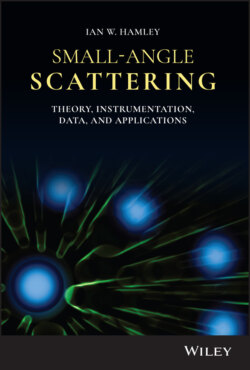Читать книгу Small-Angle Scattering - Ian W. Hamley - Страница 15
1.4 GUINIER APPROXIMATION
ОглавлениеThe Guinier equation is used to obtain the radius of gyration from a simple analysis of the scattering at very low q (from the first part of the measured SAS intensity profile). The Guinier approximation can be obtained from Eq. (1.18), substituting the expansion [6, 7, 11]:
(1.21)
gives at sufficiently low q (such that the expansion can be truncated at the second term)
(1.22)
Considering the expression for the radius of gyration as the second moment of p(r) (Eq. (1.20)) we obtain [6, 11, 12]
(1.23)
Using the series expansion with , and truncating at the second term (valid if q is small), this can be rewritten as an exponential
(1.24)
This is the Guinier equation. A Guinier plot of lnI(q) vs q2 has slope at low q. Figure 2.8 shows representative Guinier plots. The Guinier equation (Eq. (1.23)) can also be obtained starting from Eq. (1.10), using the same series expansion for the exponential exp[−iq.r].
For a homogeneous sphere of radius R, the radius of gyration is given by [6, 11] whereas for a homogeneous infinite cylinder of radius R it is given by and for a thin disc of thickness T, [6, 7, 10, 13]. For an ellipse with semiaxes a and b, . For a rod of length L with finite cross‐section the overall radius of gyration, Rg, is related to that of the cross‐section Rc via the expression [7, 11, 12, 14]:
(1.25)
The Guinier approximation is useful for systems containing non‐interacting particles (i.e. the structure factor S(q) = 1, see Section 1.5) and is typically valid for q < 1/Rg.
